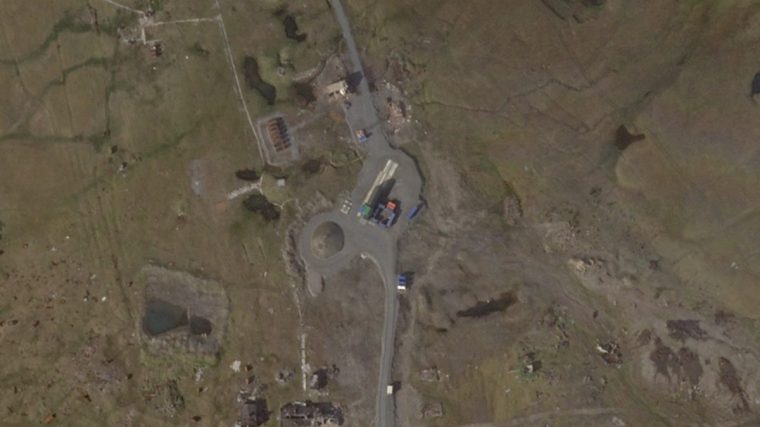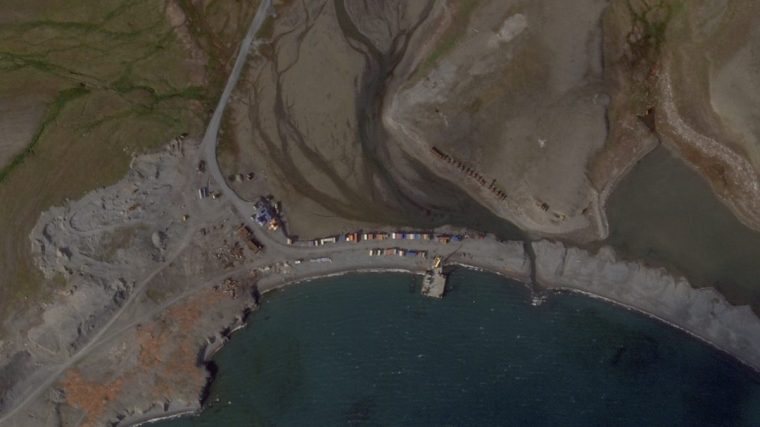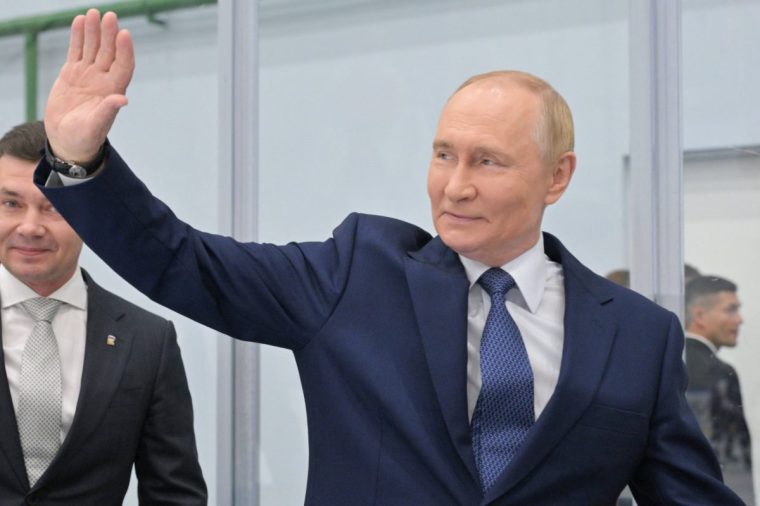Satellite images suggest Putin is preparing to test an ‘invincible’ nuclear missile – as he enters crunch talks with Trump on ending war in Ukraine
Vladimir Putin has issued a new nuclear threat against the West with preparations to test a new missile in a move aimed at gaining bargaining power in talks on Ukraine with Donald Trump.
Satellite imagery captured just days before the summit in Alaska between Trump and Putin appears to show preparations for a nuclear-armed cruise missile test at Russia’s Pankovo test site on the Barents Sea archipelago of Novaya Zemlya.
The imagery, captured by commercial satellite firm Planet Labs, shows extensive activity, including increases in personnel and equipment, as well as ships and aircraft associated with earlier tests of the 9M730 Burevestnik (known as the SSC-X-9 Skyfall by Nato).
The Burevestnik is a Russian low-flying, nuclear-powered, nuclear-armed cruise missile whose range, according to the Kremlin, is unlimited. Putin boasted that it was “invincible” and could evade American missile defences when he unveiled it in 2018.
Two US research institutions – the California-based Middlebury Institute of International Studies and the National Security Analysis centre in Virginia – concluded through separate assessments of satellite imagery that Russia was preparing to test its new nuclear-armed, nuclear-powered cruise missile.
One Western security source confirmed to Reuters that preparations were under way to test the Burevestnik.

Tests are ‘reminder’ to Trump of Russia’s nuclear arsenal
International security experts who spoke to The i Paper were widely in agreement that the preparations for the missile test were a strategic move by Russia to gain bargaining power.
The Burevestnik was among the “exotic” nuclear-capable weapons unveiled by Putin in a 2018 speech used to “threaten the West with Russia’s nuclear innovations,” Erin D Dumbacher, Stanton Nuclear Security Senior Fellow at the Council on Foreign Relations, said.
She told The i Paper: “In preparing for talks in Alaska, the Russian side would likely be looking for ways to remind the Trump administration of the sizeable Russian nuclear force and recent activities to field the so-called ‘exotic’ nuclear systems.
“They would probably expect the US and Western intelligence communities as well as open-source researchers to notice their test preparations. They might be looking for a way to remind the US side that Russia is developing a system that could, in theory, evade missile defences.
“This test is another attempt to shift the conversation about Ukraine’s future into Moscow’s preferred terms,” Dumbacher added.
The remarks were backed by Melanie Garson, Associate Professor in International Security and Conflict Resolution at UCL, who said the test could be “designed to create the perception of threat” and possibly an effort to “push the US to talk arms control” during the summit, deflecting from talking about Ukraine.

Meanwhile Lukasz Kulesa, Director of Proliferation and Nuclear Policy at the Royal United Services Institute (Rusi) think-tank, acknowledged that Russia’s “exotic” weapons were developed to provide it with a “means to overcome the current and future US missile defence systems and assure the continued credibility of Russian nuclear deterrence”, but said the test may have been left at the preparation stage to avoid provoking Trump or the humiliation of a failed test.
“The planning for such a test would have started before the announcement of the date and place of US-Russia presidential summit, but the decision to move ahead just before the meeting would be certainly seen by Trump as deliberately provocative. This may explain why it seems the test has so far been delayed.”
Highlighting that the “development phase so far has included a number of failed tests”, he added: “Russian leadership would also need to consider the consequences of a potential failure of the test, which would weaken the position of Putin.”
The tests come soon after Russia announced earlier this month that it would no longer adhere to a treaty prohibiting the use of intermediate-range missiles.
The Kremlin said it “no longer considers itself bound” by its “previously adopted self restrictions” under the 1987 Intermediate-Range Nuclear Forces Treaty (INF).
The self-imposed treaty, which Russia has repeatedly been accused of breaching, banned ground-launched ballistic and cruise missiles with ranges of 500–5,500km kilometres (311–3,418 miles).
The withdrawal came just days after Trump ordered the repositioning of two US nuclear submarines to “the appropriate regions”, without disclosing their precise location. Trump said his order was a response to “highly provocative statements” made by former Russian president Dmitry Medvedev, who accused the US of “playing the ultimatum game” by threatening to impose sanctions on Russia if it did not agree to a ceasefire in Ukraine.
Nuclear threat higher than any time since Cuban Missile Crisis
Nicholas Wheeler, Professor of International Relations at the University of Birmingham, said the “nuclear risks are higher now than any point since the Cuban Missile Crisis.”
He explained that there was a “general widespread concern in the expert community – not yet reflected in wider civil society or wider public opinion – that nuclear risks are rising”. One of the reasons behind the concern is that “it is a much more complicated nuclear strategic environment now because there are multiple players, whereas in the Cold War, it was very much a bipolar nuclear situation.”
Professor Wheeler, who is also a Non-Resident Senior Fellow at the British-American Security Information Council, also said that “a number of these multiple nuclear actors may be more risk acceptant – more willing to manipulate nuclear risk for coercive, intimidatory purposes – than was the case during the Cold War.”
Regarding Russia, Professor Wheeler said it was “engaged in manipulations of nuclear risk in a way that has been profoundly worrying in the context of the Ukraine war.

“Russia has done that in order to try to deter Nato from escalating its level of military involvement in that conflict.”
Moscow had had mixed success, however, Professor Wheeler said, because while Nato countries did not intervene directly with no-fly zones or ground-based involvement, they still offered Ukraine a significant level of military support, undeterred by Russia’s nuclear threat.
He explained that the likelihood of Russia using nuclear weapons largely depended on its success in the battlefield. Professor Wheeler pointed to October 2022, when Russia ramped up nuclear threats in the face of military pressure by Ukraine, sparking backlash from the White House as well as reported opposition by Chinese and Indian officials against using nuclear weapons.
“That seems to have been a critical month, because at that point Russia was starting to experience military losses on the battlefield that were starting to make it look increasingly likely that Ukraine might break through and threaten key strategic Russian positions,” Professor Wheeler said.
“Of course, today, we’re seeing the opposite. Russia seems to be making important military gains and the momentum seems to be in Russia’s direction, so the likelihood that they would resort to nuclear use is significantly reduced in the context where they’re having battlefield success.
“If you took away that success, then the risk might come back.”
America’s nuclear face-off with Russia and China
Professor Wheeler explained that even though the US faced two distinct nuclear threats from Russia and China, it might need to be prepared to oppose both in tandem.
He told The i Paper: “The overarching concern that is driving US strategic thinking at the moment, though the Trump administration has not yet set out its nuclear strategy, is the concern that the United States has to face the possibility it could be fighting, potentially in a nuclear situation, Russia and China at the same time. Or that if there is a nuclear crisis with one of them, the other could behave opportunistically to exploit the situation.
“The discussion taking place at the moment is around whether the US nuclear force should be sized in such a way that it could manage the nuclear threat posed by Russia and China, operating essentially in some kind of concert together.
“This problem is known as the two-peer nuclear competitor problem.
“If you say you’ve got to increase your nuclear forces to a level that can meet the combined threat posed by both Russia and China in nuclear terms, then inevitably that places you in a position of superiority over one of them. But so much for Putin today at the Alaska summit is about being recognised by Trump and the United States as a great power.
“The idea that Russia would accept any kind of inferiority to the United States on the strategic nuclear level is virtually unthinkable. Equally, China will not be comfortable being in a position of inferiority towards the United States either – they will be searching for parity and recognition as a nuclear equal. So this problem poses all sorts of challenges.”
